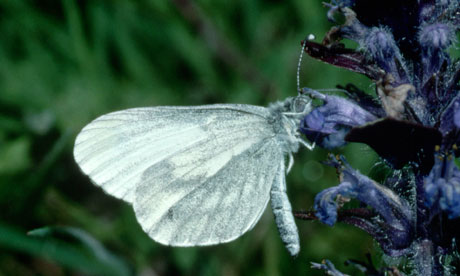Targeted conservation is reversing drastic decline in rare species, but Natural England budget cuts may jeopardise efforts

The wood white butterfly has seen a dramatic return in numbers, with a sixfold increase in sightings last year compared with 2009. Photograph: George Mccarthy/Corbis [This caption was corrected on 16 May 2011. The original referred to the white wood butterfly]
Rare butterflies are thriving after targeted efforts to conserve them in nature reserves, but experts say that government cuts could threaten endangered species.
Newly released figures from the charity Butterfly Conservation show that the endangered wood white increased in number by 600% in Britain last summer after a major decline, while the rare marsh fritillary increased by 134% and the silver-spotted skipper, once on the brink of extinction, rallied with a 78% rise.
All three have benefited from the scientific management of habitat after decades of decline triggered by industrial farming and the end of traditional forestry. But the budget for Natural England, the government agency which funds many projects, has been slashed, jeopardising thriving butterfly conservation programmes.
"Targeted conservation action works – these figures prove it," said Martin Warren, chief executive of Butterfly Conservation. "It's absolutely vital that targeted funding of species recovery is sustained to ensure these butterflies continue to thrive."
With the Department for Environment, Food and Rural Affairs forced to trim its budget by 30%, Natural England is losing staff and conservationists expect it to withdraw funding for the management of some nature reserves and delicate landscapes for butterflies and other species.
Despite these fears, a glorious spring has further boosted the population of some of the rarest insects, which are currently flying in a number not seen for a generation.
Eight years ago just eight Duke of Burgundy butterflies – probably the most endangered in Britain – were spotted in West Sussex. This year there have been more than 1,000 sightings.
"The rare species have done so well. Pearl-bordered fritillaries have gone bananas and so have Duke of Burgundies," said Neil Hulme of Sussex Butterfly Conservation, who counted 115 Duke of Burgundies on a nature reserve where he would usually spot one or two.
"It's been a cracking spring but no matter how good the weather is butterflies still need their habitats to be in good condition for them to respond," said Warren.
More than three-quarters of Britain's 59 butterfly species have declined in recent decades and despite the successful protection of some of the rarest species, many more common butterflies continue to disappear from the wider countryside.
In 2010, 21 butterfly species flew in less numbers compared with the previous year. The meadow brown suffered its worst year since butterfly monitoring began 35 years ago, while the Essex skipper suffered its second worst year . The small skipper and wall brown are two other once-common species which declined drastically.
The graceful but now critically endangered high brown fritillary and the Lulworth skipper, which is confined to the Dorset coastline and has suffered a 93% decline in number since 2000, continued to disappear from the countryside.
Butterfly numbers are recorded every year by 1,500 volunteers who submit sightings to the UK Butterfly Monitoring Scheme and the insects are a valuable indicator species, showing the health of the country's meadows, woodlands and gardens. Managing land for butterflies benefits other wildlife, including birds, bees and wild flowers.
Marc Botham of the Centre for Ecology & Hydrology, which helps run the monitoring scheme, said: "Butterflies are highly sensitive to how our countryside is changing and the UKBMS data has revealed how butterflies are already being impacted by climate change as well as whether our conservation measures are working."
The coalition's much-delayed white paper on the natural environment will be unveiled in June. Ecologists hope it will fund "landscape-scale" conservation to boost biodiversity – and halt the decline of butterflies – in the wider countryside but argue it must not neglect specific measures to protect rare species.
"The conservation of delicate and rare habitats gets the headlines but we've got to look after common habitats as well," said Hulme.
"We've got some big opportunities coming up with the nature white paper but it's important that we build on these successes," said Warren.